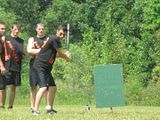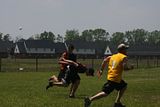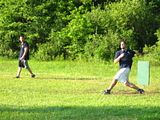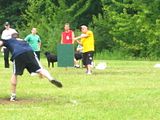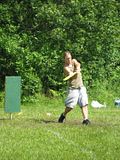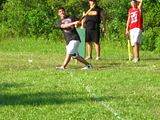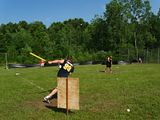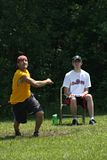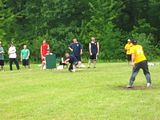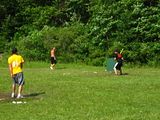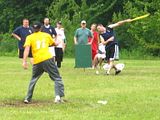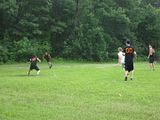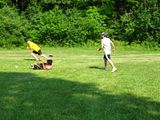You know how people will often say that they have put their blood and sweat into something to plead their dedication? Hey, Carl and I have probably let that overstatement slip once or twice in getting this league running. Well, David Buhr, captain of the Belgian Wiffles, actually has put his blood into our wiffleball Field of Dreams. The first time he came out to play at Pacman Park in the summer of 2009, he made a diving attempt on the first base side of the field. When he got up blood was streaming down his forearm. Not sure how much time actually passed, but it seemed to be a long, drawn out moment, before David finally casually said he should probably leave and get his arm taken care of. The rest of us scoured for the rest of the glass and kept saying we couldn’t believe that happened, and imagine how bad it could have been. At the field later, Carl received a text from David stating that his sister had convinced him he needed to get stitches, even though he still didn’t think it was that bad. Needless to say this was the big push for us to finally start having players sign waivers. We even considered putting up a gag advertisement for “Buhr-mese Imported Glass” on an outfield wall to commemorate David’s accident. We did not, nor was David about to give up wiffleball over a glass shard; he was one of the first signed up to bring a team to the August tournament.
This first incarnation of the Belgian Wiffles was pieced together from free agents, and the results were like trying to piece back together broken gla… Alright! I’ll stop with the glass talk! Buhr was joined by current teammate Nolan Gonyea, as well as Matt Murtha, now a Flying Squirrel, and good friend to Wiffle in Southeast Michigan, Chris Kincaide. With an 0-2 record in the double elimination tournament the team’s performance was not up to the same level as their enthusiasm. Still, there is a bright side found in 2009 for the Belgian Wiffles: Gonyea and Buhr had a .500 and .300 AVG, respectively, as well as nine walks between them in two games. So, they will get on base and then approach every play with an aggressive mindset to try to swing the momentum their way. This year, having more experience with wiffle, we should only expect the numbers from these two players to improve. Oh, and while we are talking “numbers,” Gonyea has selected the most original, stand-out uniform number in WSEM by far: 52.7!

David Buhr at bat the 2009 Downriver Wiffle Tournament
The Belgian Wiffles did not play in 2010, and when they take the field in 2011 the team will be running out a heavily restructured lineup. Power at the plate was a problem for Belgian in 2009, and wasn’t helped with the loss of Murtha, their only true power threat. So, to resolve that problem in the 2010-2011 offseason Buhr has made three signings to boost his team’s slugging numbers, as well as to shore up their pitching ranks. The first two signings, Chris Lewis and Marc Strawser, will join Buhr on the mound, and look to form a strong rotation: Buhr is an accurate pitcher, having never recorded a BB, while Lewis and Strawser are billed as confident, hard-throwers who will throw the ball by batters and likely compete to be the Belgian Wiffles’ ace. Both Lewis, a fast-pitch baseball player by trade, and Strawser, a GM at Powerhouse Gym, also look to provide some much needed power to the Belgian lineup. The most recent addition to the everyday Belgian lineup is Chuck Weiler, signed to his deal by Chris Lewis earlier this week. Weiler brings with him wiffleball experience dating back to at least 2003 in the South End Wiffle Association, and has some impressive references on his wiffle resume, having played with the Michigan's wiffleball Moses, Alan Garcia, at Fat Bastard in 2008. Weiler is not alone in his wiffle pedigree on the team either; Jay Mac, another recent signing to the Belgian roster, has also logged playing time at the Wifflehouse.
I led this article off with the “blood and sweat” joke, but the truth is David really does have a passion for this game and puts a ton of effort into it. Buhr and new teammate Chris Lewis approach their lineup in the same way David approaches his game: make every move count, play every play one-hundred percent, and, simply, just do it right. This methodology seems to be present with the whole 2011 roster of the Belgian Wiffles: the first truly assembled roster in WSEM. Although, less like “pieced together broken glass,” and much more in the way of one solid unit methodically crafted in the furnace and precisely prepared with time. They may have made something special with this lineup; do not be surprised to see the Belgian Wiffles amass a sizeable win total and go on a serious run when the games mean the most.
Team Page: http://wiffleinsemiteams.blogspot.com/p/belgian-wiffles.html
-
Brandon Corbett
Flying Squirrels, 17, P
Strike Zoning Commission Supervisor















